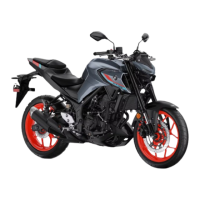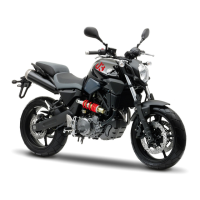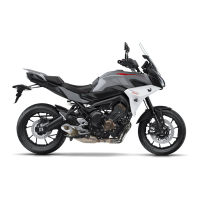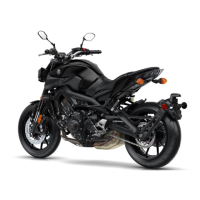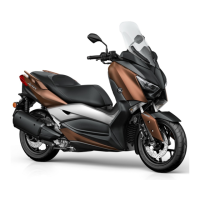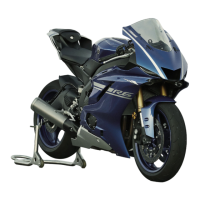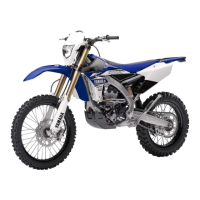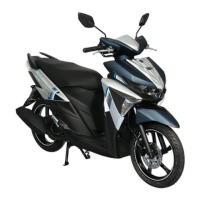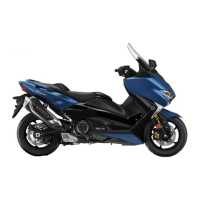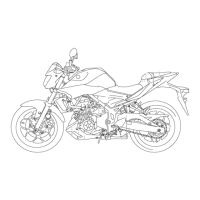
Do you have a question about the Yamaha MT-03 2017 and is the answer not in the manual?
| Engine Type | Liquid-cooled, 4-stroke, DOHC, 4-valve |
|---|---|
| Bore x Stroke | 68.0 mm x 44.1 mm |
| Compression Ratio | 11.2:1 |
| Fuel System | Fuel Injection |
| Ignition System | TCI |
| Final Drive | Chain |
| Front Suspension | Telescopic fork |
| Rear Suspension | Swingarm |
| Front Brake | Hydraulic single disc, 298mm |
| Rear Brake | Hydraulic single disc, 220mm |
| Front Tire | 110/70-17 |
| Rear Tire | 140/70-17 |
| Overall Width | 745 mm |
| Seat Height | 780 mm |
| Ground Clearance | 160 mm |
| Fuel Tank Capacity | 14L |
| Transmission | 6-speed |
| Overall Length | 2090 mm |
| Overall Height | 1, 035 mm |
| Wheelbase | 1, 380 mm |
Outlines the owner's responsibilities for safe operation and proper maintenance of the motorcycle.
Provides essential tips and precautions for safe motorcycle operation and awareness.
Details essential clothing and gear for rider safety to prevent injuries and minimize risks.
Explains the dangers of carbon monoxide from exhaust and precautions to avoid poisoning.
Provides guidelines for safely adding accessories or cargo to the motorcycle.
Information on choosing and using genuine Yamaha accessories for optimal performance and safety.
Discusses potential safety hazards of aftermarket parts and modifications.
Discusses the importance of using specified tires and rims for safe handling and performance.
Provides instructions and precautions for safely transporting the motorcycle on another vehicle.
Diagram and labels identifying key components on the left side of the motorcycle.
Diagram and labels identifying key components on the right side of the motorcycle.
Illustrations and labels for all handlebar and dashboard controls and instruments.
Explains the function and positions of the main switch and steering lock mechanism.
Details the various indicator and warning lights on the instrument panel and their meanings.
Details the components and functions of the digital meter unit, including speedometer, tachometer, and fuel gauge.
Details the function and operation of controls located on the left and right handlebars.
Explains the operation and adjustment of the clutch lever and brake levers.
Describes the location and function of the shift pedal and brake pedal.
Explains the operation and features of the Anti-lock Brake System (ABS).
Covers fuel tank cap, fuel, and overflow hose operations and precautions.
Information on the catalytic converter and safety precautions regarding the hot exhaust system.
Instructions for removing/installing seats, helmet holders, and storage compartment.
Explains how to adjust the spring preload on the shock absorber assembly.
Describes sidestand operation and the ignition circuit cut-off system.
Checks for fuel level, lines, and hoses to ensure safe operation before riding.
Checks engine oil level and coolant level and for any signs of leakage.
Checks front and rear brake operation, pad wear, fluid level, and system for leaks.
Checks clutch, drive chain, throttle grip, and cables for operation and lubrication.
Checks wheels for damage, tires for condition/tread, and air pressure.
Checks the operation of instruments, lights, signals, and switches.
Checks the operation of the sidestand switch and ignition cut-off system.
Provides step-by-step instructions for starting the engine, including conditions and warning lights.
Explains how to shift gears using the shift pedal and clutch, and provides operational tips.
Details the critical engine break-in period and recommended operating procedures.
Provides guidelines for safely parking the motorcycle, including hot components and fire hazards.
Identifies the owner's tool kit and its purpose for basic maintenance and minor repairs.
Outlines the scheduled maintenance tasks for the emission control system based on mileage.
Provides a comprehensive schedule for regular checks, adjustments, and lubrication of the vehicle.
Details how to check engine oil level and when to change oil and filter cartridge.
Emphasizes tire condition, pressure, and replacement, and checks for wheel damage and balance.
Explains how to check brake pads, fluid level, and when to change fluid and hoses.
Details how to check and adjust drive chain slack, and clean and lubricate the chain.
Covers battery maintenance, charging, and fuse replacement procedures.
Introduces troubleshooting procedures for common problems and advises using genuine Yamaha parts.
Explains how to check coolant levels and system for leaks when the engine overheats.
Advises consulting a dealer for cleaning products for matte finish parts to avoid damage.
Emphasizes regular care, cleaning, and corrosion protection for the motorcycle.
Provides instructions for short-term and long-term storage of the motorcycle.
Explains the importance of recording VIN, engine serial number, and model label for registration and parts ordering.
Identifies the location of the FI diagnostic connector for vehicle diagnostics.
Explains that the ECU stores vehicle data for diagnostics and research, with privacy considerations.
